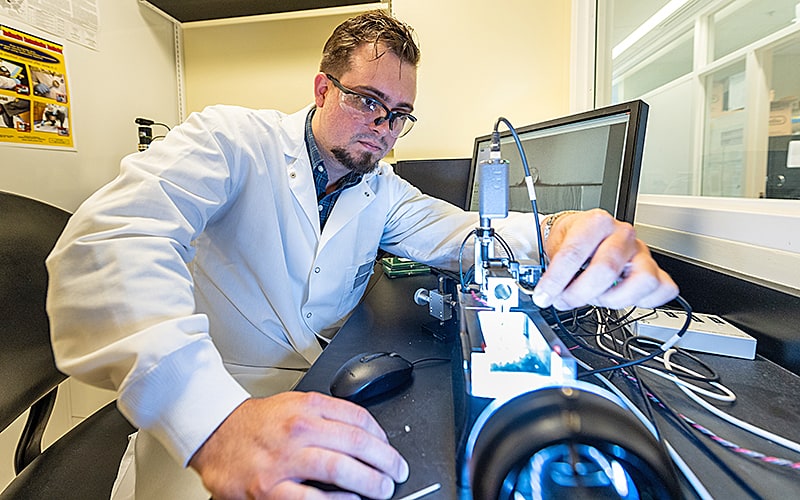Biomolecular Engineering

Biomolecular engineering takes a molecular-level approach to provide new capabilities and solve problems in the life sciences. For example, Michigan chemical engineers are developing lab-on-a-chip devices to do genetic analysis and biomolecule synthesis. We are improving drug delivery and medical imaging by studying how molecules move and distribute throughout the body. We are also studying how proteins interact with DNA and how ligand molecules interact with cellular receptors.
Maciek Antoniewicz
Professor Maciek Antoniewicz and his group study biomolecular networks and interactions in complex living systems, such as natural and synthetic microbial communities. They develop novel tools to elucidate metabolic responses of cells to perturbations, quantify the behavior and cross-feeding interactions in microbiomes, and map dynamic regulatory events. The ultimate goal of these investigations is to develop quantitative understanding of how genes, proteins, and metabolites interact, how metabolic networks are regulated, and how they can be engineered or manipulated to achieve a desired outcome, for example, producing high-value biochemicals from renewable substrates, or cure diseases such as cancer and diabetes.
Antoniewicz Group
Mark Burns
Professor Mark Burns and his group are developing lab-on-a-chip devices for genetic analysis, blood tests, and diagnosing influenza and bacterial infections. The group’s research focuses on innovative solutions to problems such as complex interconnect and packaging requirements of many pneumatically actuated analysis chips and bringing down the cost of the external optical and electronic systems needed to run them.
Joerg Lahann
Professor Joerg Lahann’s research interest is focused on the development of active, multi-functional bio-interfaces, which are applicable to a range of biomedical applications. His group’s recent advances in the molecular design of active nanostructures include the introduction of reactive coatings, reversibly switching surfaces and anisotropic nanoparticles that support the vision of smart interfaces and act as templates in time-controlled surface interactions.
Ronald Larson
Professor Ronald Larson and his group simulate drug-polymer interactions to improve drug release and delivery in the body. The group also develops methods for studying the interactions of proteins with DNA, which govern processes such as transcription. Artificial “nano-actuation” systems may be able to mimic the processes that proteins use to search DNA for their binding sites.
Sasha Cai Lesher-Pérez
Professor Sasha Cai Lesher-Pérez joined the Chemical Engineering faculty at the University of Michigan as an Assistant Professor in August 2022. The Lesher-Pérez Research Group leverages microfabrication, microfluidics, biomaterials and tissue engineered models to build microphyisiological models to study biorhythms and their role in disease and health mechanisms.
Xiaoxia (Nina) Lin
Professor Nina Lin’s research lies at the intersection of biology and engineering with a focus on microbial systems, particularly microbial communities, using systems biology and synthetic biology approaches. Her lab aims to employ engineering tools and skills such as microfluidics and quantitative modeling to help unlock mysteries of complex natural microbial communities, especially those closely associated with environment and health issues (e.g. human microbiome). In parallel, the research group exploits design principles nature utilizes and develops synthetic microbial consortia technologies to address critical needs faced by our society such as sustainable biofuel and chemical production.
Claudia Loebel
The Loebel lab’s research focus is on the design of microengineered cell culture platforms to understand self-assembly and maturation of epithelial cell organoids. The group employs tools such microfluidics and high-throughput imaging to gain fundamental insights into how cells communicate with their environment and identify new therapeutic targets for diseases such as fibrotic, inflammatory and congenital disorders.
Jouha Min
James Moon
The Moon Laboratory aims to develop novel therapeutics at the interface of immunology and engineering. Specifically, we are developing drug delivery systems designed to enhance delivery of antigen and adjuvant to lymphoid organs in the context of immunotherapies and vaccines.
Deepak Nagrath
Nagrath Lab (Systems Biology of Human Diseases)
Sunitha Nagrath
Professor Sunitha Nagrath’s research focus is the development of advanced MEMS tools for understanding cell trafficking in cancer through isolation, characterization and study of circulating cell in peripheral blood of cancer patients. Her group works on isolating and studying rare cells from cancer patients. These studies will progress to the design and development of smart chips that use microfluidics and nanotechnology to make an impact in medicine and life sciences.
Peter Tessier
Professor Peter Tessier and his group aim to develop next generation technologies for designing, discovering, engineering, characterizing, formulating and delivering biologics ranging from small affinity peptides to large monoclonal antibodies for molecular imaging, diagnostic and therapeutic applications. They use a wide range of experimental and computational approaches to generate new fundamental insights related to protein structure and function, molecular origins of protein-protein interactions, and sequence and structural determinants of key protein properties (stability, solubility, specificity and affinity). With an eye toward applications, the Tessier lab also develops novel high-throughput screening tools for discovering new biologics and identifying rare variants with drug-like properties for therapeutic applications.
Greg Thurber
Professor Greg Thurber and his group study molecules used to image diseased tissue, such as tumors, Alzheimer’s plaques and arterial plaques. The same features that allow imaging molecules to target particular tissues can also be turned to targeted drug delivery. With a fundamental understanding of how molecules distribute in the body, the team can design better molecules for imaging and therapies.
Angela Violi
The Violi group develops and applies advanced computational models to understand and
manipulate nanoscale interactions. Our research spans the development of machine learning
models for predicting nanoscale interactions, with applications in designing advanced
biomaterials and therapies, to creating theoretical models for understanding nanoparticle
transport across cell membranes, crucial for improving drug delivery and assessing nanomaterial
toxicity.
Fei Wen
To achieve cellular engineering goals of harnessing T-cells to fight disease and engineering microbes for making biofuel, Professor Fei Wen and her group use biomolecular methods such as genetic and protein engineering and protein-based nanoparticles.